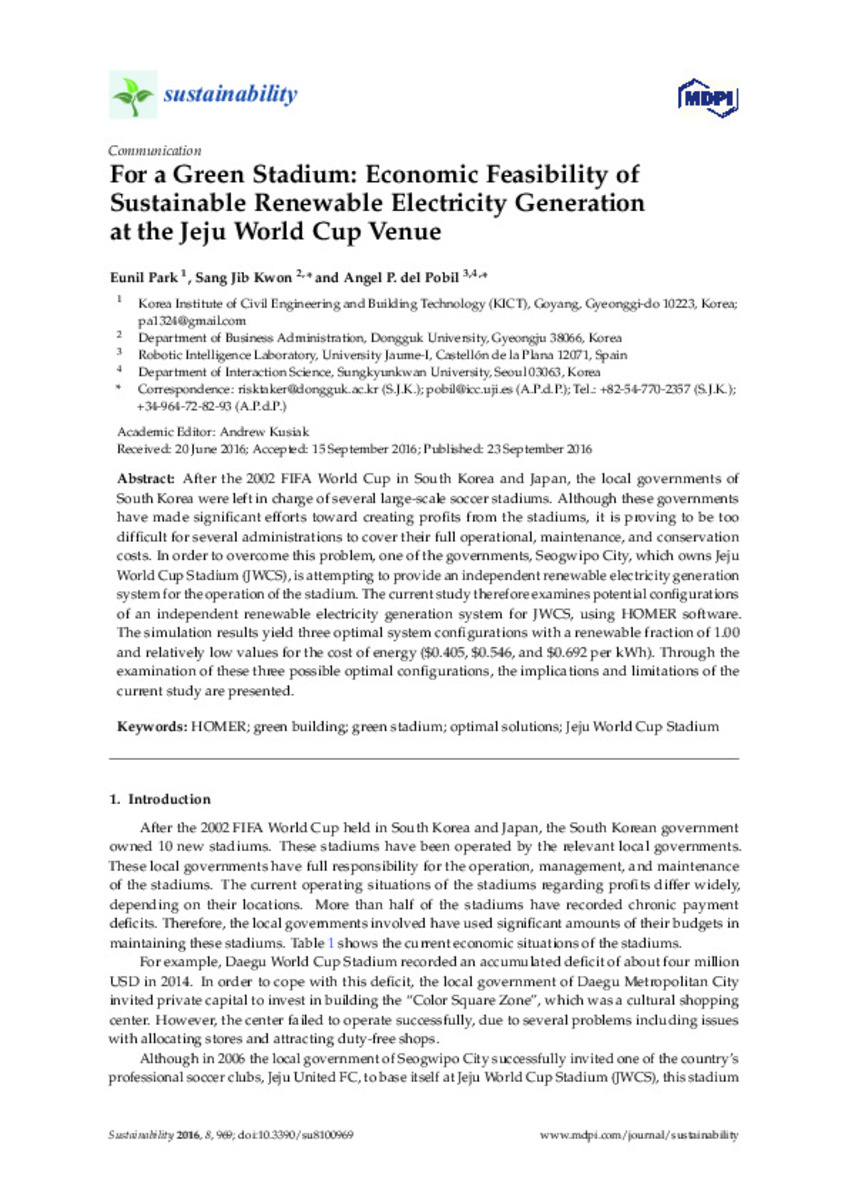Mostrar el registro sencillo del ítem
For a Green Stadium: Economic Feasibility of Sustainable Renewable Electricity Generation at the Jeju World Cup Venue
| dc.contributor.author | Park, Eunil | |
| dc.contributor.author | Kwon, Sang Jib | |
| dc.contributor.author | del Pobil, Angel P. | |
| dc.date.accessioned | 2017-03-03T19:10:50Z | |
| dc.date.available | 2017-03-03T19:10:50Z | |
| dc.date.issued | 2016 | |
| dc.identifier.citation | PARK, Eunil; KWON, Sang Jib; DEL POBIL, Angel P. For a Green Stadium: Economic Feasibility of Sustainable Renewable Electricity Generation at the Jeju World Cup Venue. Sustainability, 2016, vol. 8, no 10, p. 969. | ca_CA |
| dc.identifier.issn | 2071-1050 | |
| dc.identifier.issn | 2071-1050 | |
| dc.identifier.uri | http://hdl.handle.net/10234/166468 | |
| dc.description.abstract | After the 2002 FIFA World Cup in South Korea and Japan, the local governments of South Korea were left in charge of several large-scale soccer stadiums. Although these governments have made significant efforts toward creating profits from the stadiums, it is proving to be too difficult for several administrations to cover their full operational, maintenance, and conservation costs. In order to overcome this problem, one of the governments, Seogwipo City, which owns Jeju World Cup Stadium (JWCS), is attempting to provide an independent renewable electricity generation system for the operation of the stadium. The current study therefore examines potential configurations of an independent renewable electricity generation system for JWCS, using HOMER software. The simulation results yield three optimal system configurations with a renewable fraction of 1.00 and relatively low values for the cost of energy ($0.405, $0.546, and $0.692 per kWh). Through the examination of these three possible optimal configurations, the implications and limitations of the current study are presented. | ca_CA |
| dc.description.sponsorShip | This study was supported by the Dongguk University Research Fund of 2015. Support for the UJI Robotic Intelligence Laboratory is provided in part by Ministerio de Economía y Competitividad (DPI2015-69041-R), by Generalitat Valenciana (PROMETEOII/2014/028) and by Universitat Jaume I (P1-1B2014-52). | ca_CA |
| dc.format.extent | 11 p. | ca_CA |
| dc.format.mimetype | application/pdf | ca_CA |
| dc.language.iso | eng | ca_CA |
| dc.publisher | MDPI | ca_CA |
| dc.relation.isPartOf | Sustainability, 2016, vol. 8, núm. 10 | ca_CA |
| dc.rights | © 2016 by the authors; licensee MDPI, Basel, Switzerland. This article is an open access article distributed under the terms and conditions of the Creative Commons Attribution (CC-BY) license (http://creativecommons.org/licenses/by/4.0/). | ca_CA |
| dc.rights | Atribución 4.0 España | * |
| dc.rights.uri | http://creativecommons.org/licenses/by-sa/4.0/ | * |
| dc.subject | HOMER | ca_CA |
| dc.subject | Green building | ca_CA |
| dc.subject | Green stadium | ca_CA |
| dc.subject | Optimal solutions | ca_CA |
| dc.subject | Jeju World Cup Stadium | ca_CA |
| dc.title | For a Green Stadium: Economic Feasibility of Sustainable Renewable Electricity Generation at the Jeju World Cup Venue | ca_CA |
| dc.type | info:eu-repo/semantics/article | ca_CA |
| dc.identifier.doi | http://dx.doi.org/10.3390/su8100969 | |
| dc.rights.accessRights | info:eu-repo/semantics/openAccess | ca_CA |
| dc.relation.publisherVersion | http://www.mdpi.com/2071-1050/8/10/969 | ca_CA |
Ficheros en el ítem
Este ítem aparece en la(s) siguiente(s) colección(ones)
-
ICC_Articles [417]
Excepto si se señala otra cosa, la licencia del ítem se describe como: © 2016 by the authors; licensee MDPI, Basel, Switzerland. This article is an open access
article distributed under the terms and conditions of the Creative Commons Attribution
(CC-BY) license (http://creativecommons.org/licenses/by/4.0/).








